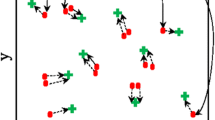Abstract
In this study, We aim to design a Dynamic Clustering scheme to maximize the Weighted Sum Rate in Ultra-Dense Cloud Radio Access Network (UD-CRAN) where mm-Wave fronthaul links with limited capacity is deployed. To improve the network performance in terms of users’ data rate, The Non-Coherent Joint Transmission is considered which is the superior transmission strategy in the limited fronthaul capacity regime. The Dynamic Clustering is proposed, which has the potential to optimize RRH selection and form a sparse beamforming vector for each user. In this study, we investigate and analyze the closed-form expressions of users’ data rate and use the \(l_1\ norm\) to approximate the non-convex fronthaul capacity constraint as a convex weighted power constraint. then, We developed a modified Successive Convex approximation-based algorithm to solve the complicated optimization problem. Our simulation results indicate that in UD-CRAN with mm-Wave fronthaul links, the proposed Dynamic Clustering improve the performance of the system significantly.







Similar content being viewed by others
Data Availability
The data that support the findings of this study are available on request from the corresponding author.
Code Availability
The code that support the findings of this study are available on request from the corresponding author.
References
Andrews, J. G., Buzzi, S., Choi, W., Hanly, S. V., Lozano, A., Soong, A. C. K., & Zhang, J. C. (2014). What will 5g be? IEEE Journal on Selected Areas in Communications, 32(6), 1065–1082.
Checko, A., Christiansen, H. L., Yan, Y., Scolari, L., Kardaras, G., Berger, M. S., & Dittmann, L. (2015). Cloud ran for mobile networks-a technology overview. IEEE Communications Surveys & Tutorials, 17(1), 405–426.
Peng, M., Sun, Y., Li, X., Mao, Z., & Wang, C. (2016). Recent advances in cloud radio access networks: System architectures, key techniques, and open issues. IEEE Communications Surveys & Tutorials, 18(3), 2282–2308.
Shi, Y., Zhang, J., Letaief, K. B., Bai, B., & Chen, W. (2015). Large-scale convex optimization for ultra-dense cloud-ran. IEEE Wireless Communications, 22(3), 84–91.
Pan, C., Elkashlan, M., Wang, J., Yuan, J., & Hanzo, L. (2018). User-centric c-ran architecture for ultra-dense 5g networks: Challenges and methodologies. IEEE Communications Magazine, 56(6), 14–20.
Chen, S., Qin, F., Hu, B., Li, X., & Chen, Z. (2016). User-centric ultra-dense networks for 5g: Challenges methodologies and directions. IEEE Wireless Communication Magazine, 23(2), 78–85.
Pan, C., Mehrpouyan, H., Liu, Y., Elkashlan, M., & Nallanathan, A. (2018). Joint pilot allocation and robust transmission design for ultra-dense user-centric tdd c-ran with imperfect csi. IEEE Trans. Wireless Communication, 17(3), 2038–2053.
Pan, C., Ren, H., Elkashlan, M., Nallanathan, A., & Hanzo, L. (2019). Weighted sum-rate maximization for the ultra-dense user-centric tdd c-ran downlink relying on imperfect csi. IEEE Transactions on Wireless Communications, 18(2), 1182–1198.
Stephen, R. G., & Zhang, R. (2017). Joint millimeter-wave fronthaul and ofdma resource allocation in ultra-dense cran. IEEE Transaction Communication, 65(3), 1411–1423.
Tanbourgi, R., Singh, S., Andrews, J. G., & Jondral, F. K. (2014). A tractable model for noncoherent joint-transmission base station cooperation. IEEE Transactions on Wireless Communications, 13(9), 4959–4973.
Pan, C., Elkashlan, M., Nallanathan, A., & Hanzo, L. (2018). The non-coherent ultra-dense c-ran is capable of outperforming its coherent counterpart at a limited fronthaul capacity. IEEE Journal on Selected Areas in Communications, 36(11), 2549–2560.
Shi, Y., Zhang, J., & Letaief, K. B. (2014). Group sparse beamforming for green cloud-ran. IEEE Transactions on Wireless Communications, 13(5), 2809–2823.
Farahmand, M., & Mohammadi, A. (2017). Sparse power allocation in joint downlink transmission of cloud radio access networks. IET Communications, 11(16), 2531–2538.
Baracca, P., Boccardi, F., & Benvenuto, N. (2014). A dynamic clustering algorithm for downlink comp systems with multiple antenna ues. EURASIP Journal of Wireless Communication Network, 125, 1–14.
Dai, B., & Yu, W. (2014). Sparse beamforming and user-centric clustering for downlink cloud radio access network. IEEE Access, 2, 1326–1339.
Awais, M., Ahmed, A., Naeem, M., Iqbal, M., Ejaz, W., Anpalagan, A., & Kim, H. S. (2017). Efficient joint user association and resource allocation for cloud radio access network. IEEE Access, 5, 1439–1448.
Shi, Q., Razaviyayn, M., Luo, Z.-Q., & He, C. (2017). An iteratively weighted mmse approach to distributed sum-utility maximization for a mimo interfering broadcast channel. IEEE Access, 5, 1439–1448.
Tran, L.-N., Hanif, M. F., Tolli, A., & Juntti, M. (2012). Fast converging algorithm for weighted sum rate maximization in multicell miso downlink. IEEE Signal Processing Letters, 19(12), 872–875.
Chen, Z., Hou, X., & Yang, C. (2016). Training resource allocation for user-centric base station cooperation networks. IEEE Transactions on Vehicular Technology, 65(5), 2729–2735.
Kailath, T., Sayed, A. H., & Hassibi, B. (Eds.). (2000). Linear estimations. Prentice-Hall.
Tse, D., & Viswanath, P. (Eds.). (2005). Fundamentals wireless communication. Cambridge Univ. Press.
Boyd, S., & Vandenberghe, L. (Eds.). (2004). Convex optimization. Cambridge Univ. Press.
Björnson, E., Sanguinetti, L., Hoydis, J., & Debbah, M. (2015). Optimal design of energy-efficient multi-user mimo systems is massive mimo the answer. IEEE Transaction Wireless Communication, 14(6), 3059–3075.
Funding
The authors did not receive support from any organization for the submitted work.
Author information
Authors and Affiliations
Contributions
The authors are with the Electrical Engineering Department, Amirkabir University of Technology (Tehran Polytechnic), Tehran, Iran.
Corresponding author
Ethics declarations
Conflict of interest
The authors declare that they have no conflict of interest.
Ethics approval
Not applicable.
Consent to participate
Not applicable.
Consent for publication
Not applicable.
Additional information
Publisher's Note
Springer Nature remains neutral with regard to jurisdictional claims in published maps and institutional affiliations.
Rights and permissions
Springer Nature or its licensor (e.g. a society or other partner) holds exclusive rights to this article under a publishing agreement with the author(s) or other rightsholder(s); author self-archiving of the accepted manuscript version of this article is solely governed by the terms of such publishing agreement and applicable law.
About this article
Cite this article
Hosseini, A.M., Mohammadi, A. Dynamic Clustering and RRH Selection in Non-coherent Ultra-Dense CRAN with Limited Fronthaul Capacity. Wireless Pers Commun 131, 1131–1148 (2023). https://doi.org/10.1007/s11277-023-10473-6
Accepted:
Published:
Issue Date:
DOI: https://doi.org/10.1007/s11277-023-10473-6




